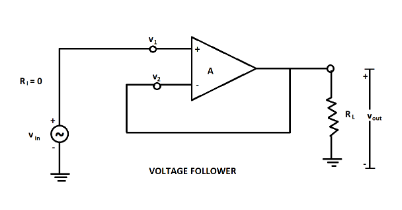
A voltage follower
A. has a voltage gain of 1.
B. is non inverting.
C. has no feedback register.
D. has all of these.
Answer
577.2k+ views
Hint: To solve this question, we have to remember that the output voltage of the op-amp exactly tracks the input voltage both in sign and magnitude. This is the reason that this circuit is called a voltage follower or unity gain configuration.
Complete answer:
A voltage follower is an electronic circuit in which output voltage tracks the input voltage both in sign and magnitude.
Because of three unique characteristics of extremely high input resistance, unity transmission gain, and extremely low output resistance, the voltage follower circuit is an ideal circuit device to serve as a buffer. Thus, it can be made to prevent the disturbance of one part of a circuit on another as might be encountered.
In voltage follower,

Output voltage, ${v_{out}} = {v_{in}}$,
From the figure, it is obvious that ${v_2}$ is equal to ${v_{out}}$ and ${v_1}$ is equal to ${v_{in}}$, so
\[
\Rightarrow {v_{out}} = A{v_d} \\
\Rightarrow {v_{out}} = A\left( {{v_1} - {v_2}} \right) \\
\Rightarrow {v_{out}} = A\left( {{v_{in}} - {v_{out}}} \right) \\
\]
Or,
$\dfrac{{{v_{out}}}}{{{v_{in}}}} = \dfrac{A}{{A + 1}} \cong 1$ for A >> 1
Thus, for voltage follower, ${A_f} = 1$
Therefore, we can say that a voltage follower has a voltage gain of 1, is non inverting and has no feedback register.
So, the correct answer is “Option D”.
Note:
The direct connection to the output voltage to the inverting terminal of the op-amp represents the case of 100% negative feedback of the output to the input. Voltage follower is used to increase the input impedance of the system to avoid loading effect.
Complete answer:
A voltage follower is an electronic circuit in which output voltage tracks the input voltage both in sign and magnitude.
Because of three unique characteristics of extremely high input resistance, unity transmission gain, and extremely low output resistance, the voltage follower circuit is an ideal circuit device to serve as a buffer. Thus, it can be made to prevent the disturbance of one part of a circuit on another as might be encountered.
In voltage follower,

Output voltage, ${v_{out}} = {v_{in}}$,
From the figure, it is obvious that ${v_2}$ is equal to ${v_{out}}$ and ${v_1}$ is equal to ${v_{in}}$, so
\[
\Rightarrow {v_{out}} = A{v_d} \\
\Rightarrow {v_{out}} = A\left( {{v_1} - {v_2}} \right) \\
\Rightarrow {v_{out}} = A\left( {{v_{in}} - {v_{out}}} \right) \\
\]
Or,
$\dfrac{{{v_{out}}}}{{{v_{in}}}} = \dfrac{A}{{A + 1}} \cong 1$ for A >> 1
Thus, for voltage follower, ${A_f} = 1$
Therefore, we can say that a voltage follower has a voltage gain of 1, is non inverting and has no feedback register.
So, the correct answer is “Option D”.
Note:
The direct connection to the output voltage to the inverting terminal of the op-amp represents the case of 100% negative feedback of the output to the input. Voltage follower is used to increase the input impedance of the system to avoid loading effect.
Recently Updated Pages
Master Class 12 English: Engaging Questions & Answers for Success

Master Class 12 Business Studies: Engaging Questions & Answers for Success

Master Class 12 Economics: Engaging Questions & Answers for Success

Master Class 12 Social Science: Engaging Questions & Answers for Success

Master Class 12 Maths: Engaging Questions & Answers for Success

Master Class 12 Chemistry: Engaging Questions & Answers for Success

Trending doubts
What are the major means of transport Explain each class 12 social science CBSE

Which are the Top 10 Largest Countries of the World?

Draw a labelled sketch of the human eye class 12 physics CBSE

Explain sex determination in humans with line diag class 12 biology CBSE

The pH of the pancreatic juice is A 64 B 86 C 120 D class 12 biology CBSE

Explain sex determination in humans with the help of class 12 biology CBSE




